

Inside Nihon Goshin Aikido ~ #74
September 2019
Inside This Edition:
- Dojo Report: A Jacket Grab Application and A Neat Cool Down Exercise You Might Enjoy Trying During Open Mat Time
- Being a “Good” Bad Guy
Greetings Nihon Goshin Aikido Aficionados!
So September is an interesting month for me. It is the first month of the busy season for my business, my birth day month, and it has a way of sort of running out the end of summer. Generally I enjoy September, but never as much as I enjoy June, July, and August.
As I reported last month, training time at the new dojo in Columbia, SC has been solid. Two 2-hour sessions each week allow us to accomplish a ton of work off of very little commitment time. Most people train about twice a week, and then only for an hour long session. The two hour sessions at my dojo allow for 4-hours worth of training on the same number of commitment days promotes maximum progress ~ and we all love progress.
Last week we were working on putting some Aiki into a 2 hand Jacket Grab application. It is pretty cool. I've posted the video to the left, and here are the steps:
1. Unbendable Arm Principle with your control hand
2. Pivot your center which breaks uke's balance as you bend his wrist
3. Grab the other wrist
4. Rotate back
5. You have not moved, and Uke is at your feet. Transition to an Arm Bar (not shown in the video).
I've posted another cool down video you might like to the left.
Other points. Uke Nagashie sword blocks are cool. Check them out. Sort of synomous with Steven Seagal's interpretation of aikido, but they will work anywhere. In an article I wrote a while back, I mistook these blocks as WingChun blocks, but the origin of Uke Nagashi is Samurai sword play. Here are some videos explaining two of the Uke Nagashi blocks and how to use them. If you are a fan of the Spin Around, you'll love these blocks as they create instant Spin Around Applications.
September completes the last instillation of the Uke Behavior Series. Here goes:
Aikido ~ NGAexperience.com's "The Official Uke Follow Me Guide: How to Be a 'Good' Bad Guy."
Part 6 of 6:
Beginning a few months ago , I began a series of articles discussing the aspects that all good ukes should manifest. The aim of every Uke is to be a "good" bad guy ~ we hope to highlight actions that promote good uke behavior in this ongoing series.
Watch almost any generic aikido video you see on youtube, and it will typically be saturated with what I define as generally "unnatural" uke behavior. Now let me be clear, I am not being critical of the act of Aikido ukemi ~ the falls and rolls ~ or the act of receiving the technique. The falls are great ~ if not spectacular. When I reference unnatural uke behavior, I am referencing the simple fact that the attacking intention of uke is typically negligent in many respects ~ if not possibly even non-martial in many training scenarios and demos.
"Good" Bad Guys don't have to strike with lethal intentions, but every strike should have these qualities:
1) The strike should be on target (Covered in the March 2019 edition of the newsletter),
2) The strike should be delivered with a closed fist, as opposed to an open hand (Covered in the April 2019 edition of the newsletter),
3) The strike should be delivered with uke's conviction to stay in the fight (not tossed out there and immediately followed by a self inflicted flop onto the mat), (Covered in the May 2019 edition of the newsletter)
4) The striker should always seek a combination punch (in other words uke's non striking hand should be kept martial throughout nage's technique), (Covered in the June 2019 edition of the newsletter)
5) The uke should look for a way to counter nage's technique, (Covered in the July/August 2019 edition)
6) Uke doesn't need to say anything between attacks ~ just train. (This month's topic).
This month we are considering Quality #6 ~ Uke does need to say anything in between attacks. Generally, there should be very little talking on the mat. We are at the dojo to train, so we should train.
There are all kinds of reasons why you want to talk, but most of those reasons are superfluous, and keep you from training.
1. To Train, You Must Train
Consider this antecodote: I once took a few golf lessons. The guy trying to help me would talk about the golf swing for 15 minutes. He'd describe the swing in great detail. He'd also hit a few golf balls ~ showcasing the perfect form of the golf swing, and describing the intricacies as he did so. About 30 minutes into my 1 hour lesson, he'd ask me to hit a few golf balls ~ and the balls would go everywhere. He'd repeat the explanation of how to hit the golf ball. Then I'd hit a couple more,and they'd fly everywhere all over again. He'd watch without saying anything, and then he'd comment," You just need more practice." Then he'd tell me a story about hitting golf balls somewhere, and finally look at his watch and then say, "Oh, we're out of time. Good Job. Keep Practicing. See you next week." In an hour, I might have hit 15 golf balls during the whole lesson, and listened to stories about golf for the rest of the time. Not suprisingly, a lack of progress led me to only take only few golf lessons, and I am pretty sure I still suck at golf because I haven't even tried to hit a ball in 20 years. I was literally "talked" out of playing the game.
Have you ever had a dojo experience like that, where everyone is talking about the perfect technique and no one is actually doing anything resembling a technique? I see it all the time.
2. Don't Let Mats Deter Your Training
I am somewhat of a mat afficianiado, and at some of the places I have trained, the mats were extremely unforgiving, and honest ukemi was a rarity at these dojos for this reason. Anyway at these places, the students would spend all kinds of time talking and not training ~ because no one wanted to be thrown on the smooth equivelant of the Wal-Mart parking lot. I got a really thick gi top to add my own layer of personal matting. If you are in a situtation like that, get a thicker gi. It makes a world of difference.
3. Students Correcting Students Wastes Time (toe stomp warning)
Partner Corrections to the Classical Techniques can be such an obsticle to effective training, and waste a lot of time. Can I get an "Amen?" Seriously, if I could categorize my biggest frustration as a new NGA student, it would be NEVER feeling like I knew what the correct version of the Classical Technique was, and having to listen to my training partner correct me instead of finding the technique by doing the technique, or doing it wrong so many times that Sensei would come over and fix it.
There was the version my Sensei introduced to me. He would teach it so clearly. Then he'd walk away, and I'd start working on the new technique with my training partner (usually someone who outranked me), and this guy would immediately begin talking and telling me to do it differently. But it wouldn't end there. At a training session a few days later another training partner would tell me to do it another way... It was a nightmare. All this time talking was limiting my training, and a lot of the help was counterproductive. These training partners were all trying to be helpful, but it was confusing, if anything, and it kept me from learning by training. As a result, I spent most of my time as a Kyu student with a lot of questions about what I was supposed to be doing Classically, and not much time actually doing it.
Looking back, I only wanted to know what the guy in charge wanted me to do. I coveted the attention and correction of my Sensei, and I cringed when my instruction and corrections were put into the hands of someone I knew had no idea what he was talking about ~ especially when he wasted a lot of my training time by telling me how it should be done.
Consider this anecdote as a rather extreme example of my experience on the matter:
Three months into my training, I was getting ready to test for my Yellow Belt. As such, I was reviewing my first 10 Classical Techniques with a purple belt I'll call "Don." When I did the Mugger's Throw, he said, "What was that?" I said "I think it's called 'The Mugger's Throw." He said, "No man. You've got it all wrong! This is how you do the Mugger's Throw" and he proceeded to execute a maximum effort Shoulder Throw on me. We were training in a section of the dojo with only an 8 foot clearance with exposed ceiling trusses. My heel clipped one of the ceiling trusses, as I unexpectedly did my first high break-fall from about 6 feet. I had never even seen the Shoulder Throw up until that moment. The breath knocked out of me, eyes glassed over, and completly bewildered, I stood back up, and he did the throw a couple more times to me before someone finally stepped in and stopped him. Relaying the experience to another black belt student, I was told that at a minimum, Don owed me a steak dinner ~ but I never got that steak, and the review for my Yellow Belt test was cut short due to concussion symptoms which developed after those Shoulder Throw breakfalls.
The point is that all of these student led corrections waste time. Let your nage do the techniques to the best of his ability. If nage has a question, call over your Sensei. He is the one responsible for student development/promotions, so let your Sensei do his job. Who knows, he might even spot a flaw in your execution of the technique.
Concluding, let’s focus on being good ukes and cut the chitchat so your nage can train!
I hope you have a great month in training. Let's meet together on the mat and soon.
Click Here for A Random Archived "Inside Nihon Goshin Aikido" Newsletter Edition
Mystery Articles of Interest
I hope you have a great month in training. Let's meet together on the mat and soon.
Jonathan Wilson
Ngaexperience.com

Unless otherwise stated, the author’s views, musings, and opinions do not necessarily reflect the attitude of leadership within any of the various Nihon Goshin Aikido associations, or unaffiliated Nihon Goshin Aikido dojos.
2014 - 2021 ngaexperience.com
Sweet Arm Bar Application from the Bottom of the Fight.
If you can cross your legs, you can do this technique.
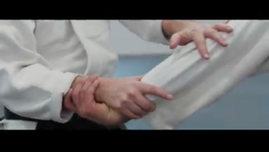
Want a Solid Arm Bar?
1. Ki Finger of Gripped hand Extended
2. Shuto Driving Fulcrum Just Above Elbow
3. Power from Tenkan Hip Pivot Driving Uke Off His Base and to the Ground

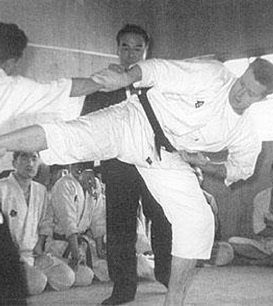
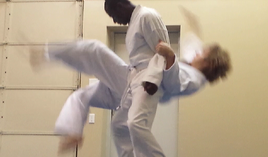
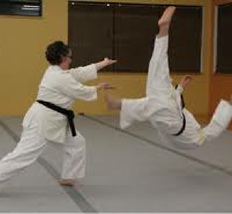
2 Hand Jacket Grab Application
(With Aiki)
Suwari waza or Kokyu Dosa
Cool Down
2 Hand Wheel Throw => Arm Bar
Uke Nageshi Blocks
Tenkan & Irimi

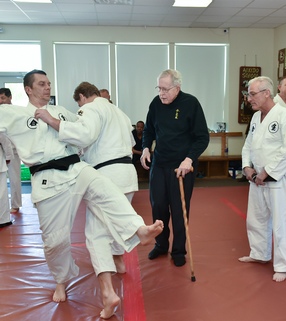
Doing the Leg Sweep incorrectly here.
Do you see the mistake?
The contact point is my thigh instead of my calf.